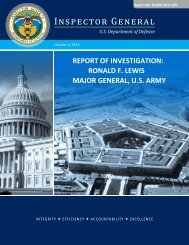Command Red Team
2gWzzvB
2gWzzvB
Create successful ePaper yourself
Turn your PDF publications into a flip-book with our unique Google optimized e-Paper software.
1. Background<br />
CHAPTER I<br />
INTRODUCTION TO THE COMMAND RED TEAM<br />
a. After studying factors that contributed to a series of strategic miscalculations and<br />
intelligence failures before and after 11 September 2001, Congressionally-directed<br />
commissions (e.g., 1998 Jeremiah Panel, 1998 Rumsfeld Commission, 2004 9/11<br />
Commission, and 2005 Weapons of Mass Destruction [WMD] Commission) and other<br />
advisory boards (e.g., RAND Corporation, Defense Science Board, and Institute for<br />
Defense Analysis) urged the adoption of red teams in an effort to reduce risk, avoid<br />
surprise, spot opportunities, increase operational flexibility, broaden analysis, and<br />
enhance decision making. Throughout this same period, professional journals explored<br />
how red teams could help organizations adapt to change and improve military planning<br />
and intelligence analysis by stimulating critical and creative thought. In December 2004,<br />
the Director of National Intelligence was required by law to establish, within elements of<br />
the intelligence community (IC), a process and responsibility for conducting alternative<br />
analysis (commonly referred to as “red team analysis”) of the information and<br />
conclusions in intelligence products (The Intelligence Reform and Terrorism Prevention<br />
Act of 2004, Section 1017).<br />
b. In 2006, the Joint Staff directed establishment of the Joint Intelligence Operations<br />
Center (JIOC) and the routine employment of red teams (“Joint Chiefs of Staff Joint<br />
Intelligence Operations Center [JIOC] Execute Order,” 031640Z April 2006). However,<br />
no guidance on how to organize and integrate red teams within the joint force was<br />
provided. Subsequent field experience indicates that consistent guidance is needed to<br />
ensure the teams and the staffs they support share a common understanding of red team<br />
objectives, concepts, and requirements.<br />
2. The <strong>Command</strong> <strong>Red</strong> <strong>Team</strong> Overview<br />
a. The command red team is a decision support element that provides an<br />
independent capability to fully explore alternatives in plans, operations, and intelligence<br />
analysis. <strong>Command</strong> red teams help commanders and staffs think critically and<br />
creatively; challenge assumptions; mitigate groupthink; reduce risks by serving as a<br />
check against complacency and surprise; and increase opportunities by helping the<br />
staff see situations, problems, and potential solutions from alternative perspectives.<br />
Implicit tasks are to counter the influence of institutional and individual bias and errors;<br />
provide insight into the mindsets, perspectives, and cultural traits of adversaries and other<br />
relevant actors; and help explore unintended consequences, follow-on effects, and unseen<br />
opportunities and threats. <strong>Red</strong> teams reduce risk by helping organizations hedge against<br />
uncertainty and anticipate, understand, prepare for, and adapt to change.<br />
b. The command red team is distinguished from a non-command red team by its<br />
place within an organization and by its scope. A command red team is positioned to<br />
assist in all aspects of the command’s processes and activities equally, without falling<br />
I-1



